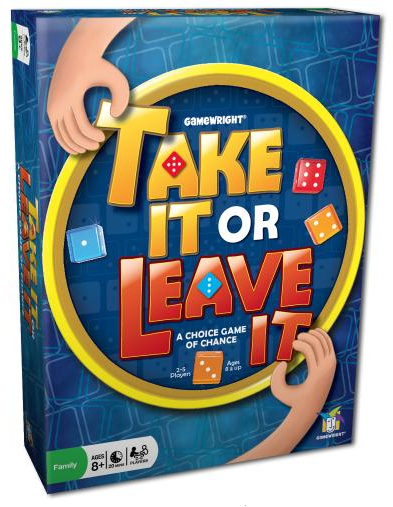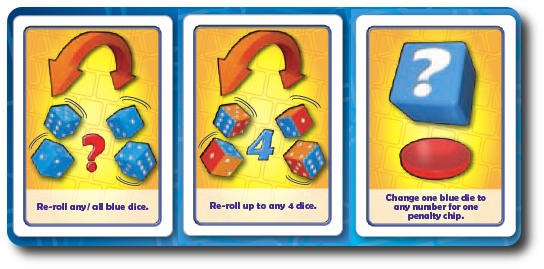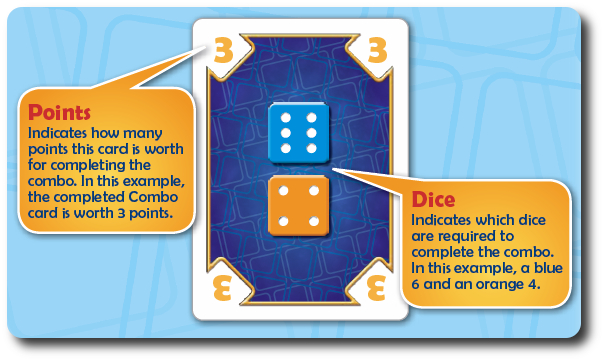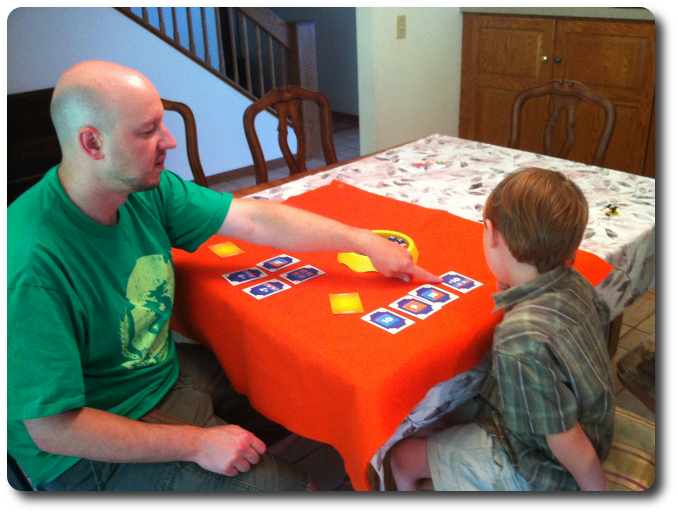
The Basics:
- For ages 8 and up
- For 2 to 5 players
- Approximately 20 minutes to complete
Geek Skills:
- Counting & Math
- Logical & Critical Decision Making
- Reading
- Pattern/Color Matching
- Risk vs. Reward
Learning Curve:
- Child – Easy
- Adult – Easy
Theme & Narrative:
- None
Endorsements:
- Gamer Geek approved!
- Parent Geek approved!
- Child Geek approved!
Overview
As the dice tumble and change, so too does the fortunes of the players. A single roll of the dice might provide much opportunity or nothing of value. With the use of cards that can shift the dice and change the outcome, all the players must race to collect the dice values and colors they need before they are altered and made useless. This is a game of timing, of judging how much risk is acceptable so as to make big points, and getting what you can before someone else does! Get in, get out, take it, or leave it!
Take It or Leave It, by Gamewright, is comprised of 76 Combo cards (blue background), 34 Action cards (yellow background), 30 Minus chips, 20 six-sided dice (9 blue, 9 orange, and 2 red), and 1 dice tray. All the game bits are high quality, thick plastic, and very durable. Best of all, it fits perfectly back in its box no matter how many times you take it out to play with it.

Game Set Up
To set up the game, first separate the Combo and Action cards (easy to do based on the card’s back color) and shuffle each into two separate decks.
Second, deal out to each player 4 Combo cards and 1 Action card, face-down. Players should keep their cards hidden from their opponent’s at all times until played.
Third, place the two decks within easy reach of all the players, face-down, and leave enough room for each to have its own discard pile.
Fourth, place the dice tray in the middle of the playing area and then place a number of dice into the tray as determined by the number of players (table is provided in the rules). Any unused dice are put back in the game box for the duration of the game.
You are now ready to play! Determine who the first player is and begin the first round of the game.
Actions, Penalties, and Ca-Ca-Ca-Combos!
The Action cards allow the player to complete a specific action they otherwise would not be allowed to do during the game. For example, re-rolling all the blue dice in the dice tray. Action cards can only be played during the player’s turn and only affect the dice left in the tray or those already taken by the active player. Action cards can never be used against an opponent’s collected dice.

Example of 3 Action cards in the game
Minus chips count as penalties and reduce the player’s overall score at the end. These are collected when certain Action cards are used and when dice are taken but not used with a Combo card. All Minus chips are kept in front of the player for the duration of the game, reducing their overall points at the end.
Combo cards are what the players use to collect points in the game. Each Combo card will list what dice are required to collect the Combo card for points and how many points the card is worth once it is completed. The more points the card is worth, the more complicated the combination that must be completed. Scored Combo cards are set to one side along with any Minus chips to be added to the player’s final score at the end of the game.

Dice Chucking
The player who is starting each round will take all the dice and roll them into the dice tray. Starting with the player who just rolled the dice, each player will take one of two actions on their turn during the round going clockwise.
Play Action Card & Take One Die or Take One Die
A player selects and plays one of their Action cards, completing whatever action is noted on the card, and then takes one die from the tray. Playing Action cards is always optional and only one Action card can be played per round. Regardless if an Action card is played or not, one die is taken from the die tray and placed in front of the player, being careful to ensure the rolled value does not change.
Play Action Card & Pass or Pass
A player selects and plays one of their Action cards, completing whatever action is noted on the card, and then takes one die from the tray. Playing Action cards is always optional and only one Action card can be played per round. Regardless if an Action card is played or not, the player does not pick up any dice and is now out for the duration of the round.
End of the Round
The round ends when either all the dice have been collected or all the players have elected to pass. If only one player remains and all the others have passed, they can continue to take their turn until all the dice are taken or they also elect to pass, thus ending the round.
Once the round is over, scoring now takes place.
Dice can only be used for each Combo card. For every Combo card that is successfully completed using the dice, the card is set aside for scoring and the dice are returned to the try. Wild dice can be used for any color (blue, red, or orange), but their numerical value cannot be changed. Wild dice used to complete a Combo card penalize the player with 1 Minus chip.
For every die not used to complete a Combo card, the player collects 1 Minus chip. For every Wild die not used, the player collects 2 Minus chips.
All the Minus chips and completed Combo cards are set aside (face-down) and kept in a single pile by the owning player.
Optionally, all players can discard 1 of their unused Combo or Actions cards at the end of the round. Then, all player replenish their hand with 4 Combo cards and 1 Action card.
A new round now beings with the next player, going clockwise, picking up the dice and rolling them into the dice tray.
Ending the Game
The game ends after all the players have started an equal number of rounds (3 times for a 2 or 3-player game, 2 times for a 4-player game, and one time for a 5-player game). At the end of the final round, all the points are counted and the player with the most points wins the game.
Game Variation
Instead of drawing a combination of 4 Combo cards and 1 Action card at the beginning of every round, the players can draw any number of Combo or Action cards as long s their total number of cards in their hand does not exceed 5 cards.
To learn more about Take It or Leave It and read the full rules, see the game’s official web page.
Prediction
This is nothing more than a simple push your luck dice game, or is it? The Action cards allow for some changes to the dice that could greatly benefit or hinder players and the Combo cards provide more points for the more difficult dice combinations. So perhaps it isn’t as simple as it would first appear. The rules are certainly straight forward, although the Combo cards can be a bit difficult at first (this is especially true for those little geeks who have not yet learned the mathematical meaning of the “Greater Than” and the “Lesser Than” symbols), but the learning curve is pretty minimal for the entire game. The most challenging aspect of playing is knowing when to do or not to do something.
My little geeks are already very familiar with push your luck dice games, such as Martian Dice, Zombie Dice, and Trophy Buck. The added difficulty of math using the number on the dice isn’t any more complicated than keeping track of how many shotguns, tanks, or scared deer that are used in the other dice games to signify a penalty. In theory, this game shouldn’t be all that complicated. I also don’t think this is going to be a game that will be greatly loved or disliked by the Gamer and Parent Geek groups. It is very light, provides a challenge, and is fairly quick to play.
Teaching it to my little geeks took longer than I expected. The Combo cards proved to be too much for my 5-year-old to handle. He understood the majority of them, but the few he did not started to get him stressed and disinterested. My 8-year-old also had some difficulty at first but quickly started to connect the dots (so to speak) and soon was able to identify what the Combo cards meant. We practiced identifying the Combo cards by using them like math Flash cards. I would shuffle the Combo cards, draw one at random, and then ask one of my two little geeks to tell me what was needed to complete the Combo. Again, my 8-year-old quickly grasped what was needed, but my 5-year-old continued to struggle. He eventually decided the game was not for him and bowed out for the duration of the lesson. My 8-year-old was eager to play.
After answering all the questions, my 8-year-old dealt out the cards and set up the playing area. While he did so, I asked him his thoughts on the game so far.”
“Hold on…1,2,3 and 4 Combo cards and 1 Action card…OK. Yes, this looks like a fun game! Let’s play!” ~ Liam (age 8)
Whoops! Note to self: don’t ask questions to someone when they are dealing out and counting cards!
Looks like the game is ready and the dice are set to be chucked! Let’s see if this is a rolling good time or a dud from the get-go.
Final Word
My little geek did awesome and was able to collect many points during the game, completing combos and judging when was the best time to take dice or not. He often went for the fewest dice that were the “rarest” of the roll, leaving the more common and abundant dice and colors for later. This is exactly the right kind of strategy as a player can only take 1 die at a time. He did not, however, do so well when it cam to playing the Action cards. That is to say, he hardly ever played them. I am not altogether certain how much this hindered him, however, as he won as many games as he lost (8 in total). Still, I cannot help but consider how the games could have been more dynamic if he would have used his Action cards more often. He was satisfied with what was rolled and worked within those limits. He smiled the entire time except when I took a die he wanted.
Parent Geeks enjoyed the game a great deal and loved playing it with the family and their friends. The game proved to be light enough to play in a room full of screaming kids as the parent bent over the table to play the game and hear each other talk. The game was also welcoming enough for the non-gamers to sit down and enjoy it.
Gamer Geeks were pleasantly surprised with the game. They thought it was rather light but enjoyed how the player could adjust the dice and the various ways to score points with variable degrees of risk vs. reward. They all agreed it was an excellent filler and had just the right game length and difficulty to make it casual but challenging.

Teaching games to little geeks takes patience, empathy, and lots of visual examples
Gamer Geeks, this is a light but challenging push your luck dice game where you will be constantly guessing which die to take and which to leave in order to complete your Combo cards. There is enough strategic thought needed in the game to make it worth your while and some of the few tactics necessary to play the game competitively against your peer group will keep you engaged. That being said, the game isn’t going to be enough to satisfy you and is best played as a filler between games, before a gaming evening, or as the last game of the night. We suggest you play the game with the game variant, which allows players to further define their strategy by focusing in on points or the ability to shift the dice.
Parent Geeks, this game teaches and strengthens math and logical thinking, as well as pattern and color matching. All the things that your little geek needs to learn and use in their lives as they grow up. But it is also challenging enough for those who have all but mastered the early arts of simple arithmetic and pattern matching to keep them engaged and rolling. There will be many groans from the table when you take a die that another player was waiting for and many angry looks when you play an Action card that changes the visible dice. Expect good times for all, including the non-gamers who played the game just as well and as competitively as everyone else.
Child Geeks, there are two hurdles you will need to overcome to play this game well. The first is being able to correctly determine how difficult a Combo card is to achieve. This will help you decide the risk vs. reward of attempting to complete a Combo card for its points. The second is your timing in taking dice and playing Action cards. Dice are needed to score points but also count against you if you don’t use them. That means that any dice you collect in hopes of using for a Combo card can quickly become lost points if other players grab them before you. Additionally, Action cards can be real game changers. Using them at just the right time is all subjective, but there is little doubt that they can be leveraged to make a bad roll into an awesome opportunity for points. This creates a game that will keep you on your toes and need your total focus to play it well. But not so much as to give you a nose bleed.
I found Take It or Leave It to be a very enjoyable game with all three of our test groups. With the Child Geeks, the game was very light as everyone attempted to complete their combos without much thought of hindering the other players. This made the game a fun guessing exercise and a great example of what it means to have perfect timing. With the Parent Geeks, the game was much more competitive with Action cards being played just at the right time to help some players collect a lot of points (or steal them from others). With the Gamer Geeks, the game became an exercise in mind reading, balancing points taken versus points lost, and plays where the only intent was to hinder other players. In all three groups, the game provided different levels of challenge and never failed to satisfy.
If you are looking for a game of dice rolling and pushing your luck with cards that can change the landscape significantly enough to make or break a player’s smile, then get your hands on Take It or Leave It!
This game was given to Father Geek as a review copy. Father Geek was not paid, bribed, wined, dined, or threatened in vain hopes of influencing this review. Such is the statuesque and legendary integrity of Father Geek.



